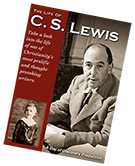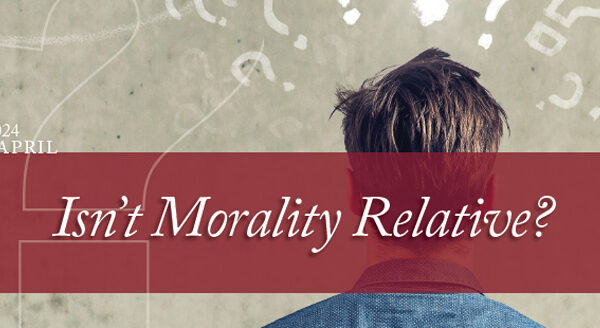Back to series


Recommended DVD
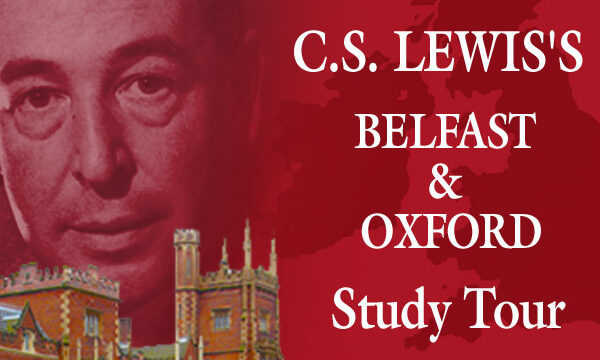
Queen’s University Belfast and the Surrounding Area - (Part 4)
(This is a four-part series on Surprised by Belfast: Significant Sites in the Life of C.S. Lewis. Part 1, Part 2 , Part 3, Part 4.)
Click here to open a Print - Friendly PDF
The three previous articles of this series focused on three locations in Belfast that have strong associations with C.S. Lewis and his family. These locations and the focus of the articles were (1) Little Lea, his boyhood home from 1905, (2) Dundela Villas, where C.S. Lewis was born in 1898, and (3) St. Mark’s Church where Lewis was baptized in 1899. Events that took place at these locations shaped Lewis’s early life and influenced it forever.
This fourth and final article in the “Surprised by Belfast” series focuses on the area of south Belfast, now often called the University Quarter. Traveling south from the city center, the University Quarter commences after passing Shaftsbury Square; it is bounded by the main arterial routes of the Ormeau Road and the Lisburn Road that run radially outward from the Shaftsbury hub until they reach the outer ring of the city. The sector enclosed by these boundaries contains the buildings that comprise the main campus of Queen’s University Belfast (QUB), the Botanical Gardens, sprawling student accommodation, dozens of church buildings, schools, coffee shops, offices, and restaurants of every description. Its heart is a thriving, bustling mixture of interesting architecture that contains the beat of new generations of young university students charting their paths in life. Within a dozen miles from the center of the city, the journey out through the University Quarter takes you through an area that gradually becomes more residential and more affluent in character, and eventually becomes the green landscapes and gently undulating hills of County Down.
Queen’s University
Although the university buildings today can boast an eclectic array of architectural styles, the school’s beginnings were mainly contained in what is known as the Lanyon Building, named after its architect Sir Charles Lanyon. The beginning of Queen’s can be traced back to the Royal Belfast Academical Institution, founded in 1810, making QUB the ninth-oldest university in the United Kingdom. In 1845 a charter was granted by Queen Victoria for the establishment of three colleges in Ireland which together were known as the Queen’s University of Ireland. The three colleges were Queen’s College Belfast, Queen’s College Cork, and Queen’s College Galway. In 1879 the three colleges were associated as the Royal University of Ireland (RUI), and in 1907 the RUI was dissolved to form two new institutions, the Queen’s University Belfast and the National University of Ireland. The current charter for QUB was established in 1908. Following the establishment of Queen’s College Belfast in 1845, the Lanyon Building opened in 1849, serving some three hundred students. It requires little imagination to capture the difference in the level of activity from those early beginnings to the current university that accommodates some twenty-four thousand students.
C.S. Lewis did not study at Queen’s. However, his mother, Florence Augusta (nee Hamilton) did. Flora was born in Ireland in 1862. In 1874 she came with her parents to Belfast from Rome, where her father, Thomas R. Hamilton, had served the Anglican community as a curate for four years at the Church of Holy Trinity. On the family’s arrival in Belfast, Flora continued her early education at Methodist College, which comprises a series of architecturally imposing buildings, occupying a large site just opposite both the Lanyon Building of QUB and the Botanical Gardens on Belfast’s University Road. On completion of her studies at Methodist College, Flora progressed to Queen’s College Belfast, where in the early 1880s she completed a BA degree in mathematics.
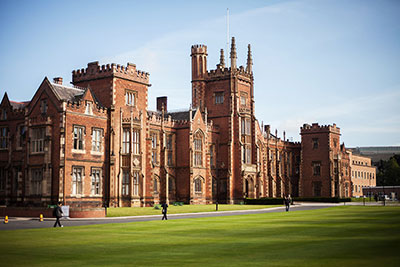 The fact that Lewis’s mother graduated from Queen’s and attended school at Methodist College is reason enough for Lewis enthusiasts to visit the University Quarter in Belfast. It was also reason enough for the university to include a C.S. Lewis reading room in the large McClay Library, part of a multimillion-pound development of the university completed in 2009, and which is now the main library building of the entire campus. The C.S. Lewis reading room was included in honor of Lewis, and it is certainly worth visiting.
The fact that Lewis’s mother graduated from Queen’s and attended school at Methodist College is reason enough for Lewis enthusiasts to visit the University Quarter in Belfast. It was also reason enough for the university to include a C.S. Lewis reading room in the large McClay Library, part of a multimillion-pound development of the university completed in 2009, and which is now the main library building of the entire campus. The C.S. Lewis reading room was included in honor of Lewis, and it is certainly worth visiting.
The room is circular in shape and has commanding views from its glazed façade over the entrance to the McClay complex, the back of the Lanyon Building, Union College, and College Park. The reading room is interesting partly because of its circular shape, but also because of its dramatic entrance, in the form of a deep doorway. The dark wooden doors create the illusion of entering the room through a wardrobe. Those familiar with the vocabulary of The Lion, the Witch and the Wardrobe hesitate momentarily if they feel inclined to close the door fully, especially when they are on the inside! Once inside, visitors are immediately aware of the large circular, glass-topped table that displays, beneath the glass, a circular map of Narnia as depicted by Pauline Baynes. In addition to the map, the walls of the room are decorated with images of Irish landscapes and with appropriate quotations taken from across the breadth of Lewis’s writing, one of which will be used to conclude this article.
No visit to the reading room and to the McClay Library would be complete without inspecting the original copy of a letter from C.S. Lewis to a little girl called Anne Jenkins. Anne read The Chronicles of Narnia and was motivated by the stories to write to the author and ask a number of questions about the narrative. As a consequence of Anne’s curiosity, we have been left with Lewis’s own précis of the seven Narnian chronicles. He sums up each book in one line as part of his reply to Anne. The complete reply by Lewis to Anne is also reproduced on a bronze sculpture of the wardrobe displayed in east Belfast, close to Lewis’s birthplace. If QUB serves to focus our attention on Lewis’s mother and on some parts of his writing, there are three other buildings in the University Quarter that have associations with Lewis and his father. The first is the Crescent Church on University Road; the others are now pleasant terrace buildings formerly used as “nursing homes.”
Crescent Church
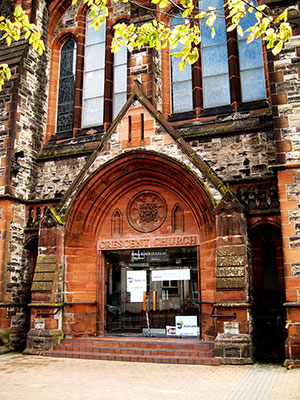 The Crescent Church in Belfast is a large sandstone structure with Gothic-style arched doorways and windows and a unique, square, open bell tower rising majestically above the adjacent buildings. Lewis refers to this church in Surprised by Joy in an amusing reflection about his father. The piece is in chapter 8, “Release,” in which he describes the process that resulted in him leaving the boarding schools to which he had been sent and entering the tutelage of W.T. Kirkpatrick to prepare for university matriculation.
The Crescent Church in Belfast is a large sandstone structure with Gothic-style arched doorways and windows and a unique, square, open bell tower rising majestically above the adjacent buildings. Lewis refers to this church in Surprised by Joy in an amusing reflection about his father. The piece is in chapter 8, “Release,” in which he describes the process that resulted in him leaving the boarding schools to which he had been sent and entering the tutelage of W.T. Kirkpatrick to prepare for university matriculation.
In the reflection, Lewis gives a humorous insight into the cross-purposes and confusions that often characterized conversations he and his brother had with their father. Lewis had formed the view in his early life that their father absent-mindedly listened to their contributions to these conversations and all too hastily jumped to his own view of what his sons were saying without fully comprehending their intents. One of these confusions involved the Greek lettering displayed in the arch above the doorway of the Crescent Church. Lewis introduces and records the conversation as follows:
A certain church in Belfast has both a Greek inscription over the door and a curious tower. ‘That church is a great landmark’, said I, ‘I can pick it out from all sorts of places—even from the top of the Cave Hill.’ ‘Such nonsense’, said my father, ‘how could you make out Greek letters three or four miles away?’1
The confusion had arisen because Lewis was referring to the curious tower above the church while his father had attended only to the reference to the Greek letters above the door. The church referenced is the Crescent Church in the University Quarter of Belfast.
Upper Crescent and College Park Belfast
The other two buildings in that immediate area were associated with Lewis and his father at a different juncture of Lewis’s life. It is altogether a much darker period of their relationship and a period lacking in humor or other mitigating circumstances.
In 1929 Lewis’s father, Albert, became unwell. The National Health Service was not in existence in Britain at that time and hospitals were not as well developed as they are today. In those days, between the two world wars, those who could afford to pay were often admitted into “nursing homes”—essentially large houses, adapted to provide private accommodation where patients could avail themselves to twenty-four-hour medical care by nurses trained to the best standards available at the time; patients were treated by doctors with skills considered appropriate to the diagnosed condition of the patient. Albert Lewis was admitted to and cared for in two such nursing homes. One was located in Upper Crescent, just across from the Crescent Church; the other was in College Park, just beside and visible from the McClay Library at QUB. In 1929 C.S. Lewis visited his father in Miss Bradshaw’s nursing home in College Park, and Albert’s burial record indicates that he died in Miss Wallace’s nursing home at Upper Crescent.
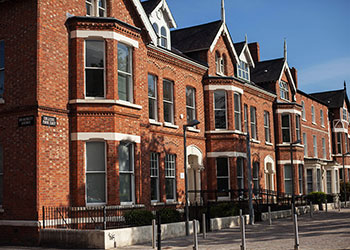 Lewis gives us some insights into those difficult weeks of the summer of 1929, spent in Belfast with his father during his illness. The first surviving record that indicates something amiss with Albert’s health is a letter from C.S. Lewis to Arthur Greeves written July 25, 1929:
Lewis gives us some insights into those difficult weeks of the summer of 1929, spent in Belfast with his father during his illness. The first surviving record that indicates something amiss with Albert’s health is a letter from C.S. Lewis to Arthur Greeves written July 25, 1929:
I have had bad news from home. First a letter from my Scotch uncle commenting on my father’s poor state of health … they suspect ‘something internal’ … Second, a letter from my cousin Joey to say that … they are putting him into a nursing home for inspection to-day … saying that they … suspect some inflammation.2
This same letter also provides an insight into the difficulty Lewis experienced in coping with the situation. Most biographers and commentators note that the relationship between Lewis and his father was not totally relaxed or comfortable.
In a letter to Owen Barfield, Lewis describes his innermost feelings:
“I am attending at the almost painless sickbed of one for whom I have little affection and whose society has for years given me much discomfort and no pleasure.”3
These sentiments along with two additional portions of the letter to Arthur Greeves of July 25, 1929, demonstrate the conflicts of the emotion Lewis was experiencing. On the one hand, this letter indicates sorrow at his father’s illness and imminent demise:
Isn’t it all beastly. Poor, poor old Pdaitabird [a nickname the boys used for their father because of his unusual pronunciation of the word Potato, which he appears to have said with a heavy emphasis on a ‘d’ sound, making it more like pdiata], I could cry over the whole thing.4
On the other hand in an earlier sentence, Lewis says:
how horrible one feels when the people whom one ought to love, but doesn’t very much, are ill and in need of your help and sympathy; when you have to behave as love would dictate and yet feel all the time as if you were doing nothing—because you can’t give what’s really wanted.5
 When I visit the locations in Belfast where these emotions were played out and observed by Lewis himself, I remember the talks he was to give many years later. In 1929 when these events occurred, Lewis was only commencing the final phase of his return journey back to Christian belief. By 1941 he had been a Christian for the best part of a decade and was giving his famous Broadcast Talks published in 1942 (later as book 1 of Mere Christianity). In Broadcast Talks he returns to these themes and to the dilemma they present. He concludes with these words:
When I visit the locations in Belfast where these emotions were played out and observed by Lewis himself, I remember the talks he was to give many years later. In 1929 when these events occurred, Lewis was only commencing the final phase of his return journey back to Christian belief. By 1941 he had been a Christian for the best part of a decade and was giving his famous Broadcast Talks published in 1942 (later as book 1 of Mere Christianity). In Broadcast Talks he returns to these themes and to the dilemma they present. He concludes with these words:
These, then, are the two points I wanted to make. First, that human beings, all over the earth, have this curious idea that they ought to behave in a certain way, and cannot really get rid of it. Secondly, that they do not in fact behave in that way. They know the Law of Nature; they break it. These two facts are the foundation of all clear thinking about ourselves and the universe we live in.6
In these words, Lewis not only expounds a great biblical truth stated by the apostle Paul in his letter to the Romans, but he also demonstrates that he recognized it in himself. That truth is stated in Romans 7:15, 18, 21, 24–25 (NIV):
I do not understand what I do. For what I want to do I do not do, but what I hate I do … I have the desire to do what is good, but I cannot carry it out … So I find this law at work: Although I want to do good, evil is right there with me … What a wretched man I am! Who will rescue me from this body that is subject to death? Thanks be to God, who delivers me through Jesus Christ our Lord!
In conclusion, I wish again to refer briefly to the C.S. Lewis reading room in the McClay Library of QUB. I mentioned in passing that the reading room walls are decorated with images of Ireland and quotations from C.S. Lewis’s writings. It is appropriate to conclude this series of articles, “Surprised by Belfast,” by using one of those quotations seen in the reading room. It has its genesis at Dundela Villas, where Lewis was born, in east Belfast:
If I find in myself a desire which no experience in this world can satisfy, the most probable explanation is that I was made for another world.7
|
Notes: |
|||

Sandy Smith
AuthorSandy Smith, is the author of C.S. Lewis and the Island of His Birth and a Director of Heritage Experience. His book is available through www.authenticulster.com. Three short film pieces on aspects of the life of C.S. Lewis can also be viewed on the website. In addition he has produced several YouTube videos of Ireland.

Recommended DVD
The Life of C.S. Lewis, A Day of Discovery Production (2005, approximately 120 minutes)
In this revealing look at the life of C. S. Lewis, go behind the scenes to see the sites he knew so well, and to meet those who knew Lewis personally.
C. S. Lewis is remembered as a scholar, teacher, and writer. He’s also been called one of the most influential spokesmen for the Christian faith in the 20th century. During his 30 years at Oxford University, Lewis produced a number of bestselling books that are still widely read today including The Chronicles of Narnia, and Mere Christianity.
This 4-part video from Day of Discovery, The Life of C. S. Lewis, explores how Lewis changed from an outspoken opponent of Christianity to one of its most powerful defenders.
 COPYRIGHT: This publication is published by C.S. Lewis Institute; 8001 Braddock Road, Suite 301; Springfield, VA 22151. Portions of the publication may be reproduced for noncommercial, local church or ministry use without prior permission. Electronic copies of the PDF files may be duplicated and transmitted via e-mail for personal and church use. Articles may not be modified without prior written permission of the Institute. For questions, contact the Institute: 703.914.5602 or email us.
COPYRIGHT: This publication is published by C.S. Lewis Institute; 8001 Braddock Road, Suite 301; Springfield, VA 22151. Portions of the publication may be reproduced for noncommercial, local church or ministry use without prior permission. Electronic copies of the PDF files may be duplicated and transmitted via e-mail for personal and church use. Articles may not be modified without prior written permission of the Institute. For questions, contact the Institute: 703.914.5602 or email us.
-
Recent Podcasts
The Side B Stories – Dr. James Tour’s story
by Jana Harmon, James Tour on April 12, 2024From a secular Jewish home, scientific scholar and...Read More
-
Why are Christians so Bad?
by Paul Joen on April 5, 2024
-
Questions That Matter Podcast – Dai Hankey and Gospel Hope for Weary Souls
by Randy Newman, Dai Hankey on April 5, 2024
-
Recent Publications
Isn’t Morality Relative?
by Christopher L. Reese on April 1, 2024It is widely accepted in the Western world...Read More
-
Do Muslims and Christians Worship the Same God?
by Andy Bannister on March 1, 2024
-
Artificial Intelligence and Its Impacts on Humanity
by John Lennox on February 13, 2024
0
All Booked
0.00
All Booked
0.00
All Booked
20599
GLOBAL EVENT: 2024 Study Tour of C.S. Lewis’s Belfast & Oxford
https://www.cslewisinstitute.org/?event=global-event-2023-study-tour-of-c-s-lewis-belfast-oxford-2&event_date=2024-06-22®=1
https://www.paypal.com/cgi-bin/webscr
2024-06-22

Next coming event
Days
Hours
Minutes
Seconds
GLOBAL EVENT: 2024 Study Tour of C.S. Lewis’s Belfast & Oxford
On June 22, 2024 at 12:00 pmat Belfast, Northern Ireland & Oxford, EnglandCategories
Speakers

Sandy Smith
Author
Team Members

Sandy Smith
AuthorSandy Smith, is the author of C.S. Lewis and the Island of His Birth and a Director of Heritage Experience. His book is available through www.authenticulster.com. Three short film pieces on aspects of the life of C.S. Lewis can also be viewed on the website. In addition he has produced several YouTube videos of Ireland.



